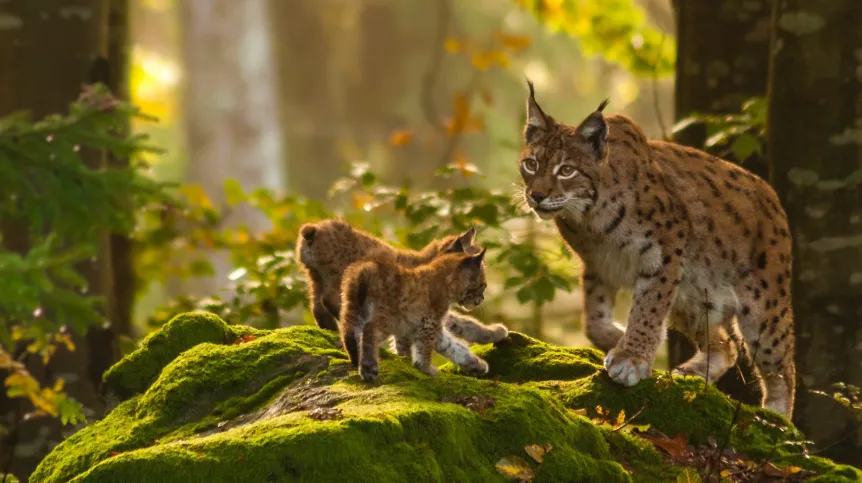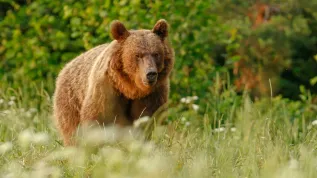
Despite being a protected species, the lynx do not colonize all forests in Poland. New research shows that most forests do not meet key requirements, such as the presence of undergrowth or type of terrain, that give these predators the opportunity to hunt.
Large European predators, including the lynx, are generally considered forest animals, scientists from the Mammal Research Institute of the Polish Academy of Sciences in Białowieża remind in a press release sent to Science in Poland. They add that Poland is a country with a fairly high degree of afforestation - forests cover almost 30 percent of the country.
'So far, however, lynx have not been able to naturally colonize all forest areas. It is strange considering that these cats have been under strict protection for many years, so it would seem that nothing prevents their population from inhabiting all available forests. One of the reasons for this is probably the lack of continuity of the environment, which makes it difficult for these forest cats to move freely over long distances. However, at the same time, our second protected large predator - the wolf - has made a significant territorial expansion despite these limitations', the biologists write.
Taking this into account, they wanted to clarify whether, apart from fragmentation of the environment, there were other factors that could make it difficult for the lynx to permanently settle in Polish forests.
They took into account previous results of their research in the Białowieża Forest, which showed that lynx have very specific environmental requirements. Like other big cats, they hunt by stalking, so their environment must contain shielding elements that allow them to approach their prey unnoticed and effectively obtain food.
Further research, the results of which have just been published in the journal Animal Conservation (http://doi.org/10.1111/acv.12873), showed that among the available habitats in Poland, the lynx living in lowland areas preferred forests with a relatively high degree of undergrowth , and those in mountainous regions - areas with the most diverse terrain. It was therefore assumed that these landscape elements could be indicators of the availability of cover in the environment, necessary for these cats.
The researchers attempted to assess the extent to which Polish forests met such conditions - and, consequently, how many of them were fully suitable for inhabitation by these large, demanding cats.
On the basis of data on the places of occurrence of the lynx in Poland and various environmental data, an analysis of modelling of habitat suitability for this predator on a national scale was carried out using GIS (Geographical Information System) tools. The research was first carried out on a macro scale - taking into account general, quantitative data on the spatial distribution of natural environments (such as forests or wetlands) and man-developed areas (agricultural land, built-up areas, roads). Next came micro-scale studies, including an analysis of the presence of elements in the environment that could provide cover for hunting lynx. For this purpose, the researchers used topography data and data from the State Forests Information System, containing information on the share of undergrowth in the forest structure.
Habitat suitability modelling carried out on a macro scale indicated the existence of as much as 110,000 km2 of available forest areas, half of which were classified as high-quality habitats. They included large forests in western Poland, which are beyond the natural range of the lynx. However, the micro-habitat model built taking into account the undergrowth and topography reduced the area of high-quality habitats to only 33 percent of the forests identified on a macro scale. In other words, most forests in Poland do not meet the key requirements for lynx, important due to the way these predators obtain food, the authors of the study report.
Moreover, the distribution of forests rich in undergrowth or with varied terrain largely coincides with the current distribution of the natural lynx population in eastern and southern Poland. Therefore, it can be assumed that forests with a simplified structure (lack of undergrowth) are an obstacle to the natural expansion of this predator's range.
'Importantly, the analyses also showed the presence of small patches of habitats that met the requirements of the lynx in western Poland. They play an important role in the current program of these cats' reintroduction in this part of the country. The lynx released into the wild largely choose the environments indicated by the model. These studies suggest that microhabitat structure may play a key role in the successful conservation of the Eurasian lynx', the authors of the study report.
PAP - Science in Poland
zan/ agt/ kap/
tr. RL













